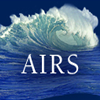|
Walter Torres Postdoctoral Scholar wtorres@apl.washington.edu Phone 206-685-4050 |
|
Publications |
2000-present and while at APL-UW |
Curvature dynamics of a coastal barotropic outflow jet on a slope Torres, W.I., and J.L. Hench, "Curvature dynamics of a coastal barotropic outflow jet on a slope," J. Phys. Oceanogr., 54, 2041-2056, doi:10.1175/JPO-D-23-0220.1, 2024. |
More Info |
1 Sep 2024 |
|||||||
|
This study adopts a curvature dynamics approach to understand and predict the trajectory of an idealized depth-averaged barotropic outflow onto a slope in shallow water. A novel equation for streamwise curvature dynamics was derived from the barotropic vorticity equation and applied to a momentum jet subject to bottom friction, topographic slope, and planetary rotation. The terms in the curvature dynamics equation have a natural geometric interpretation whereby each physical process can influence the flow direction. It is shown that a weakly spreading jet onto a steep slope admits the formulation of a 1D ordinary differential equation system in a streamline coordinate system, yielding an integrable ordinary differential equation system that predicts the kinematical behavior of the jet. The 1D model was compared with a set of high-resolution idealized depth-averaged circulation model simulations where bottom friction, planetary rotation, and bottom slope were varied. Favorable performance of the 1D reduced physics model was found, especially in the nearfield of the outflow. The effect of nonlinear processes such as topographic stretching and bottom torque on the fate of the jet outflow are explained using curvature dynamics. Planetary rotation has a surprisingly strong influence on the nearfield deflection of an intermediate-scale jet given a sufficient topographic slope. The deflection of the jet across steep slopes affects cross- and alongshelf transport patterns in the tropics. |
|||||||||
Coral restoration for coastal resilience: Integrating ecology, hydrodynamics, and engineering at multiple scales Viehman, T.S., and 15 others including W.I. Torres, "Coral restoration for coastal resilience: Integrating ecology, hydrodynamics, and engineering at multiple scales," Ecosphere, 14, doi:10.1002/ecs2.4517, 2023. |
More Info |
21 May 2023 |
|||||||
|
The loss of functional and accreting coral reefs reduces coastal protection and resilience for tropical coastlines. Coral restoration has potential for recovering healthy reefs that can mitigate risks from coastal hazards and increase sustainability. However, scaling up restoration to the large extent needed for coastal protection requires integrated application of principles from coastal engineering, hydrodynamics, and ecology across multiple spatial scales, as well as filling missing knowledge gaps across disciplines. This synthesis aims to identify how scientific understanding of multidisciplinary processes at interconnected scales can advance coral reef restoration. The work is placed within the context of a decision support framework to evaluate the design and effectiveness of coral restoration for coastal resilience. Successfully linking multidisciplinary science with restoration practice will ensure that future large-scale coral reef restorations maximize protection for at-risk coastal communities. |
|||||||||






